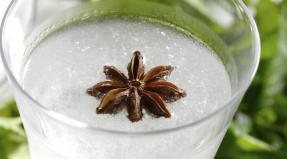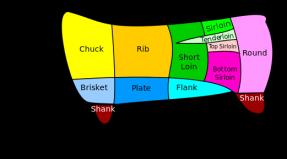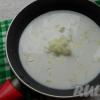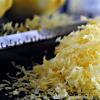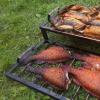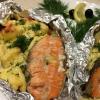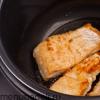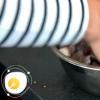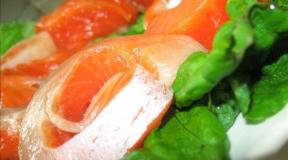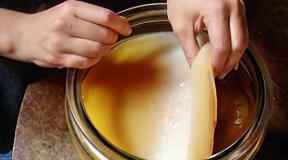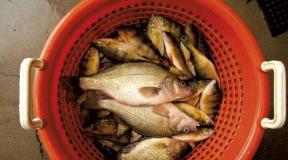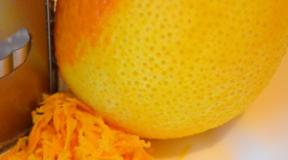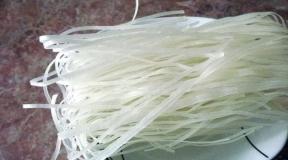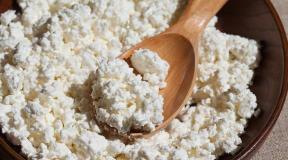Thick edge of beef: what is it and how to cook it correctly? Recipe for beef thin edge What is prepared from the thin edge of beef.
Cutting a beef carcass
This is the simplest carcass cutting scheme.
Even inexperienced amateur cooks are well aware that one of the criteria responsible for the softness of various cuts of beef is the ability to choose the right piece from the cut of the carcass. Pieces of meat from the middle part of the back (there are muscles that only support the body and are not involved in movement) have a more delicate structure.
The entrecote and sirloin parts taken from here, including, among other things, the sirloin tenderloin and a thick edge, are great for cooking many dishes, including steaks.
In the forearm, thigh, chest and rib cuts, on the contrary, the connective tissue is highly developed.
The average development of connective tissue is in the dorsal and scapular-cervical cuts.
The meat on the back of the carcass is more tender, well suited for frying and grilling, while the meat on the front is strong-smelling, tougher and requires slow cooking with the addition of liquid.
There are various ways to cut beef: American, British, Dutch, Italian, German, Danish, Australian and South American.

American carcass cut

British way of butchering

Dutch way of carcass cutting
The South American scheme is also common, in which the whole carcass is divided into 19 numbers, let's look at this scheme in more detail

Front cut:
No. 1 - entrecote on the bone (Cube Roll)
No. 2 - thick edge (Ribs)
No. 3 - brisket (Brisket)
No. 4 - shoulder blade (Shoulder)
No. 5 - shoulder-shoulder part (roast from the shoulder blade)
No. 6 - false fillet (Blade)
No. 7.8 - shank (Shank)
No. 9 - thin edge (Thin ribs)
No. 10 - neck (Neck)
Rear cut:
№11 - thick fillet (flat roast beef) (sirloin)
№12 - fillet (tenderlion)
No. 13 - butt, rump (rump)
No. 14 - the top of the rump (Top rump, Nuss - German)
No. 15 - the pulp of the thigh (Silver side)
No. 16 - the inner part of the hip cut (Top side)
No. 17 - flank (flank)
No. 18 - back ankle (shank)
No. 19 - white meat for roasts (Weiß Braten)
If you buy, for example, dry-frozen meat in a supermarket, it always has a number on it, and you know exactly which part you are purchasing.
But alas, even here, there are differences in the number distribution system.
And when buying on the market, it is still desirable to know why you need a piece of meat, what part of the carcass it is from and what this part is called.

Russia has adopted its own beef cutting plan(by the way, not much different from those above) and its own terminology, which will be useful for all avid meat-eaters to know:
1-2.Neck(upper and lower part) - this meat belongs to the second grade, it is better to buy it in the form of minced meat. The lower part of the neck used to be called a hryvnia, and the upper part was called a cut.
3. shoulder blade- this meat belongs to the first grade, it is quite suitable for stewing (goulash, stew) and frying, but it requires a long time to cook.
4-5. Rib part (thick edge)- first-class meat, in its entirety consists of 13 ribs: the first 3 are attached to the lower part of the shoulder blade, they are removed; the next 4 ribs are usually sold as a whole piece, which is cooked like bone-in meat, but the bones can be cut off and the meat can be cooked in the form of a roll; the next 3 ribs contain more meat; the rest of the ribs are a rather expensive cut of tender meat.
6. Loin (thin edge, roast beef)- a first-class cut of tender meat that can be fried and grilled; in the middle of this part is a tenderloin (fillet).
7. Rump- First-class lean meat for frying and grilling.
8. Ham (rump, thigh)- first-class meat, lean cut, which is well suited for stewing in a pot, and for a steak with blood; this part of the carcass can be salted, stewed or fried. The part closest to the tail is called the “hump” and goes to the roast.
9. Shank- lean beef of the third grade, intended for stewing (the name refers only to the back leg) or for boiling broth.
10-11. Barrel (flank)- rather cheap meat of the second grade, used for stews or stews.
12. Upper rib (hem)- lean meat; it is freed from bones, rolled up and used, for example, for stewing in a pot.
13. Brisket- first-class meat; it is sold without bones in the form of a roll and is suitable for boiling, stewing, soups (for example, for pickle), in stews and pilaf.
14. knuckle- meat of the third grade, requires long cooking (the name refers only to the front leg).
A few words about the juiciness of beef - for sure, some of the former meat-eaters moved to the enemy camp of vegetarians, dislocating their jaw in an attempt to chew a sole-shaped entrecote or breaking a tooth on a granite steak ... Supporters of low-fat diets will have to come to terms - the juiciness of beef (alas!) directly depends on its fat content. In one of the best varieties of American beef, called "marble" (marble beef), lean flesh alternates with the thinnest fatty streaks - they make the taste of meat so juicy and tender.
Of great importance for the juiciness of meat is the method of frying. The more moisture the meat loses in the pan, the drier and tougher it becomes. Therefore, you should not cook excellent tenderloin in fat or oil - fresh juicy meat is best fried in a dry hot frying pan for several minutes on both sides, and salt each side only after browning. By the way, it is best to beat beef on a board moistened with cold water, as a dry tree absorbs meat juice.
For the preparation of meat dishes, it is best to use the meat of young animals. It is easy to distinguish by color. The meat of animals under the age of six weeks has a color from light pink to light red and dense white internal fat. The meat of young animals (up to two years old) is light red in color with almost white fat. The meat of adult animals (two to five years old) is juicy, tender, red. In older animals (over five years old), the meat is dark red, the fat is yellow pork. The best nutritional properties have beef obtained from animals under the age of five years, pork - from animals 7-10 months of age and lamb - from 1-2-year-old animals.
Benign meat is covered with a thin crust of pale pink or pale red color and does not stick to the fingers in the places of incisions. When feeling its surface, the hand remains dry, the pits from the pressure of the fingers quickly disappear. To determine the freshness of meat, you can pierce it with a heated knife or fork. If it is of poor quality, the knife or fork acquires an unpleasant odor.
Choosing the right part of the beef carcass
Figure - Beef carcass cutting scheme (varietal cuts)
Table - Description of the parts of cutting beef carcass
| № | Name of the part of carcass cutting (cuts) | Variety | Characteristics, features of the carcass part | The purpose of the part of the carcass |
|---|---|---|---|---|
| 1 | Neck, cut | 3 | Contains a considerable amount of tendon, but has good taste. |
Cooking (including long-term), stewing. Dishes: dressing soups and broths, minced meat, meatballs, goulash, cholent, aspic (jelly). |
| 2 | Dorsal part (thin edge, thick edge, entrecote) |
1,2 |
May be sold with bones. Thick edge - soft, fine-fibered meat, contains 4.5 ribs. The thin edge has excellent palatability, contains 4.5 ribs. Entrecote is a selected soft intercostal part of the meat, located along the vertebrae. |
Frying, baking (including large pieces), stewing. Dishes: soups (rib part), chopped cutlets, goulash, roast, steak (from a thin edge), roast beef (thin, thick edge), meat on ribs, entrecote. |
| 3 | Thick loin, sirloin | Tender meat, thin layers of fat. |
Frying (including fast), stewing. Dishes: cutlets, cue balls, meatballs, beef steak, beef stroganoff (upper part of the butt), zrazy, rolls, various minced meats and fillings. |
|
| 4 | Tenderloin, fillet | The most valuable and tender part of the meat, lean, without streaks |
Frying, baking a piece. Good for grilling. Dishes: roast beef, steak, chops, barbecue, azu. |
|
| 5 | Rump | Distinguished by its softness. Good taste qualities. The inside is the most valuable. |
Stewing, boiling, frying, minced meat, baking. Dishes: cutlets, meatballs, beef stroganoff (inner part), soup, broth. |
|
| 6 | Rump (mid-thigh), probe (inner thigh), butt (lower thigh) | Low-fat fine-fiber meat, good taste. |
Stewing, boiling, baking. Dishes: cutlets, roast beef, soups, broths. |
|
| 7 | Peritoneum, flank (curl) | The texture of the meat is rough, but the taste is not bad. May contain fat, bone, cartilage and film. |
Minced meat, boiled. Dishes: meatballs, meatballs, rolls, soups, zrazy, borscht, broth. |
|
| 8 | edge trim | The meat contains layers of fat. It has excellent taste qualities. |
Boiling, stewing, minced meat. Dishes: goulash, azu, meatballs, dressing soups. |
|
| 9 | shoulder blade |
Slightly coarse fibers. Shoulder - lean meat, may have thick streaks. |
Cooking, stewing, minced meat. Dishes: steak, goulash, azu, chopped cutlets, roll. |
|
| 10 | Brisket | The meat has a layered structure, contains fatty layers. Good taste qualities. |
Boil, stew, bake, chop (stuff). Dishes: roasts, soups, borscht. |
|
| 11 | thigh | Not the best in consistency, but has a good taste and aroma (thanks to gelatin). |
Slow frying and stewing in large chunks. Dishes: goulash, azu, soups. |
|
| 12 | Shank | A lot of tendons, connective tissues. Contains marrow and gelatin. Good taste qualities. Stickiness after cooking. |
Slow cooking. Dishes: broths, jellies (jelly). From the pulp it is possible: cue balls, meatballs, meatballs, rolls, etc. |
|
| 13 | knuckle | Same as the shank. | Like a shank. |
Like any meat, beef is best stored in the refrigerator.
The shelf life of frozen beef is slightly longer than that of pork and lamb - about 10 months. Veal - 8 months.
The duration of maturation of beef after slaughter is approximately 2 weeks at a temperature of 1-2 degrees Celsius. As the storage temperature increases, so does the maturation time. Without the use of a refrigerator, the meat will ripen within a few days, but in this case, the shelf life will decrease dramatically.
This cutting scheme is also common on the network.
1. Filey. This cut includes the last two dorsal vertebrae with their corresponding ribs, without the lower third, and the first five lumbar vertebrae. The muscle tissue of the sirloin is distinguished by exceptional tenderness and a fine-fibred structure, especially the internal lumbar muscles (tenderloin), located from the 1st lumbar vertebra to the ilium. As a rule, at meat processing plants, tenderloin is separated and sold as a semi-finished product at a price higher than meat of the 1st grade. Rump steaks, kebabs, roast pieces, boiled meat are prepared from the muscle tissue of the fillet.
2.Butt. This cut contains a large amount of tender meat on the last three ribs. The sirloin can be fried whole with or without the bones, or it can be cut into portions for frying steaks over an open fire or in a pan. The fillet steak is prepared without bones; to prepare a steak with a bone, the meat is cut off from the front part of the butt along with the rib: the steak from the back of the lumbar part of the butt contains a piece of tender tenderloin that lies under the spine. If the tenderloin is cooked separately, it can be fried whole, but is most commonly cut into pieces across the grain to make steaks.
3.Rump. A primal cut containing O lower vertebrae of the spine and pelvic bone. All bones are usually removed and the meat is cut across the grain in portions to make tender, delicious steaks. Rump steaks can be fried both on an open fire and in a pan. Pieces weighing more than 1.5 kg make an excellent roast beef, which is usually cooked over high heat.
4. Edge. Thick edge. A primal cut containing 4 or 5 ribs with relatively soft and fine-fibred meat. To make excellent roast beef, the ribs are usually cut short and the meat tied; the bones can be removed completely, in which case the meat is rolled up before tying. The meat can also be used for stewing or roasting in large pieces.
Thin edge. A primal cut containing 4 or 5 ribs, from which roast beef is usually made two or three ribs thick. The meat of the thin edge is very tender and is ideal for making roast beef. To preserve the aroma and juiciness, the thin edge should be baked in the oven along with the bones at a high temperature, after sawing through the upper parts of the dorsal vertebrae. Excellent taste and steaks from a thin edge, and meat on the ribs, cooked on the grill.
5. Little falcon. The front thickened part of the brisket (at the level of five ribs), called the falcon brisket, is the most valuable in terms of nutrition, it is used for making fatty and fragrant cabbage soup, borscht and broths.
6. Rump. The rump is an excellent cut of meat between the sacrum and the pelvic bone. Most often, this meat is used to prepare high-quality roast beef by slow frying.
7. Brisket. After removing the breast bone and ribs, a long, flat piece of meat is left, which is usually rolled up and tied. Pieces of the required length are usually cut off from it and sold. The layered structure of the muscle tissues of the brisket is emphasized by fatty layers, the taste is good. Brisket must be cooked in a humid environment. Sometimes it is stewed, but more often it is boiled - either fresh or salted (the brisket is traditionally used for pickling).
8.Pobederok and probe, rump, sec. These four cuts together make up the top of the hind leg. probe- a cut of lean, thin-fibered meat from the inside of the thigh - good for slow frying and stewing. Meat sex a bit rougher but still good tasting and is commonly used for slow roasting or stewing, as well as for salting and simmering. This meat is most often used to make quality roast beef by slow roasting. The thigh is good for slow frying and stewing in a large piece, but quite often it is cut into portions, which are stewed or fried in a pan.
9. Flank. This cut consists of muscle tissue covering the ribs with layers of fat. Excellent meat for cooking. because it has good taste, and the layers of fat in it help retain moisture. The meat can also be stewed with or without bones, cut into slices or cubes. Quite often, pokromka is used to prepare minced meat.
10.Shoulder blade. The shoulder bone contained in the primal cut is removed by the butcher, and the meat is cut into portions for making steaks or for stewing. The palatability of the meat is high, the fat content is relatively low. Some pieces have thick streaks of connective tissue, with which the muscles attach to the scapular bone. This connective tissue is left on the meat, as when cooked in damp heat, it softens, releasing sticky substances into the broth.
11. Neck. The meat of the neck contains a large percentage of connective tissue, and therefore, in order to acquire the required softness, it needs long-term heat treatment in a humid environment. However, it has good taste and is inexpensive. Neck meat is usually sold diced or minced.
12. Rulka. The muscular front leg (knuckle) contains a marrow and several narrow, pronounced muscles with a thick layer of connective tissue and tendons. After removing the bone, the meat is usually cut into circles across the fibers or into cubes for stewing. When cooked in a humid environment, the gelatin of the connective tissues turns into a decoction, forming a very tasty and nutritious gravy. The knuckle is especially suitable for French-style beef stew.
13. Zarez. The muscle tissue of the notch is dark red, coarse-fibrous, with a large amount of connective tissue. Use it for preparation of broths, jellies, forcemeat.
14.15.Shank. The fleshy part of the hind leg is rich in tendons: like the shank, it contains the brain bone and a large percentage of connective tissue. Usually the bone is removed and the meat is cut into thick slices or cubes. Delicate aroma and high content of gelatin give this meat excellent taste in stew.
Let's summarize our knowledge:
BEEF FOR COOKING:
- broth - bones;
- broth and boiled meat - rump, butt, brisket, brisket, knuckle, flank;
- meatballs - meat of the III grade.
BEEF FOR FRYING:
- entrecote - thick and thin edge;
- brizola - tenderloin;
- steak - tenderloin, thick and thin edge;
- langeta - tenderloin;
- rump steak - tenderloin, rump, rump;
- spreader - thick and thin edge;
- beef stroganoff - tenderloin, butt, rump;
- chopped cutlets - shoulder blade, thigh.
BEEF FOR BAKED DISHES:
- baked meat - rump or rump:
- roast beef in English - sirloin;
- clippings in English - clipping;
- roll - shoulder blade, thigh.
BEEF FOR STEWING:
- goulash - shoulder blade, brisket, knuckle, neck, rump, thigh, rump;
- roast - rump or rump, shoulder blade;
- shtufata - rump or rump, shoulder blade;
- roll - rump or rump, shoulder blade;
- zraz chops - rump or rump, thigh, thick and thin edge;
- zraz chopped - spatula.
BY-PRODUCTS:
- boiled - tripe, tongue, salted tongue, heart;
- fried - brains, liver;
- stewed - kidneys, goulash from the heart.

Another source and another diagram:

1 - head,
2 - neck, cut,
3 - sirloin,
4 - bang,
5 - thick edge,
6 - middle of the shoulder blade,
7 - thin shoulder blade, knuckle,
8 - thin edge,
9 - from the edge of the edge,
10 - sternum,
11 - thin fillet,
12 - arable,
13 - curl, arable land,
14 - thick loin,
15 - barrel,
16 - English fillet,
17 - rump,
18 - middle of the thigh,
19 - rump (not included in the picture, inner thigh),
20 - sec, thigh; ossicle, part of the section, with the acetabular bone,
21 - shank.
Beef is divided into 3 varieties.
Top grade includes:
- back,
- chest parts
- filet,
- shanks,
- rump and rump;
To the first- shoulder and shoulder parts, as well as flank;
To the second- notch, front and back shank. http://idilbay.ru/1gov.php
How to choose a piece of beef that is suitable for a particular recipe? This question has two aspects. The first concerns lovers of exclusive products: beef varieties. The second aspect is important for any culinary specialist: this is the cutting of beef carcass and the correct use of its specific pieces.

Marinades for beef
The science of marinades is not as complicated as it seems. Moreover, being carried away by the preparation of "bouquets" and how they are fancifully reflected in the taste of the finished meat, you begin to get real pleasure. The marinade must certainly contain an acidic component, which will start the fermentation process and help make the meat softer in a few hours. In our kitchens, there is always a lot of sour - obvious and non-obvious. it citrus fruits (lemon, lime, orange) and simply sour fruits (kiwi, pineapple, plum) and berries (gooseberries, currants, sea buckthorn), ginger, mustard, pomegranate narsharab. It is good to grate the onion for the marinade - it is the juice that is important from it. It’s just that vinegar is advised to be avoided - it “knocks out” the meat spirit from the meat.
Pickled meat and in the Indian manner - in kefir or yogurt, in a ratio of 1: 1 with mineral water with gas. This base makes it soft and retains juiciness. For the same purpose, olive oil is added to the wine marinade. There are unexpected ingredients: dark beer (especially in combination with mustard), soy sauce and even vodka. But the most creative marinade has recently been made from Vietnamese fish sauce nam pla and blue cheese- pasta from them has a magical effect: it softens the meat and gives it a special flavor.
jamieoliver.comIngredients
- 250 g of onions;
- 2 cloves of garlic;
- 1 green pepper;
- a little olive oil;
- 500 g beef shank;
- 1 tablespoon of paprika;
- 1 ½ l beef broth;
- 2 tomatoes;
- ½ tablespoon of cumin seeds;
- a little red wine vinegar;
- a few sprigs of fresh marjoram;
- sea salt - to taste;
- 200 g potatoes.
Cooking
Cut the onion into half rings, chop the garlic, remove the seeds from the pepper and cut it into cubes. Pour the olive oil into a saucepan and cook the vegetables over medium heat until softened.
Good beef should be red or light red in color and without dried edges.
Cut the beef into small cubes and cook along with the vegetables until the meat is browned. Add paprika, stir and cook for 2 more minutes. Then pour in 200 ml of broth, bring to a boil and cook until the volume of liquid is halved.
Add finely chopped tomatoes, cumin seeds, vinegar, tomato paste and chopped marjoram. If you can't find fresh herbs, replace them with a tablespoon of dried marjoram. Season with salt and pepper.
Pour in half of the remaining broth and cook over low heat for 1.5-2 hours. After that, put the diced potatoes in a saucepan, add the broth and cook until tender. If the soup seems thick to you, add a little hot water during cooking.
 delish.com
delish.com Ingredients
- 450 g spaghetti;
- 2 eggs;
- 50 g of grated parmesan;
- 1 onion;
- 3 cloves of garlic;
- 450 g ground beef;
- 800 g of pureed tomatoes;
- salt - to taste;
- ground black pepper - to taste;
- 250 g ricotta;
- 350 g grated mozzarella;
- a few sprigs of parsley.
Cooking
Boil in salted water until al dente according to package instructions. Drain the water, add 1 egg and parmesan to the spaghetti and mix thoroughly.
Heat olive oil over medium heat. Put the chopped onion into the oil and cook for about 5 minutes until it softens. Add finely chopped garlic and stir in vegetables. Put the minced meat and fry it for about 6 minutes.
Then add tomato paste to the filling, mix, and after a minute add the pureed tomatoes, oregano, salt and pepper. Cook over low heat for another 10 minutes. In a separate bowl, mix the ricotta and the remaining egg.
Place some meat filling in the bottom of a baking dish. Top with half the spaghetti, half the filling, half the ricotta and half the mozzarella. Repeat the layers one more time and put the lasagna in the oven preheated to 180 ° C for 25 minutes. Sprinkle with chopped parsley before serving.
 jamieoliver.com
jamieoliver.com Ingredients
- 1 ¹⁄₂ kg beef;
- 2 medium onions;
- 2 carrots;
- 2 celery stalks;
- 1 head of garlic;
- 1 bunch of herbs, such as a mixture of thyme, rosemary, bay leaf and sage;
- sea salt - to taste;
Cooking
Remove the beef from the refrigerator half an hour before cooking to bring the meat closer to room temperature.
If the meat is old and tough, coat it with mustard, leave for an hour and rinse before cooking.
Wash the onions, carrots and celery well and chop them coarsely. Divide the garlic into cloves. It is not necessary to peel vegetables. Place the vegetables and herbs on the bottom of a baking sheet and drizzle with olive oil.
Tie the meat with a rope, brush with olive oil and season with salt and pepper. Place the beef on top of the vegetables and place the baking sheet in a preheated oven at 240°C. Then immediately reduce the temperature to 200°C. Roast the beef for an hour or a little longer depending on your preference.
If the vegetables start to burn, add some hot water to the pan. And to make the meat juicier, pour it with fat from the bottom of the pan.
 jamieoliver.com
jamieoliver.com Ingredients
- 800 g beef fillet;
- 2 tablespoons of flour;
- a little olive oil;
- 2 cloves of garlic;
- 5 small onions;
- 2 celery stalks;
- 4 carrots;
- ½ bunch thyme;
- 4 small ripe tomatoes;
- 150 ml of red wine;
- 500 ml beef broth;
- a little Worcestershire sauce;
- 2 fresh bay leaves;
- sea salt - to taste;
- ground black pepper - to taste.
Cooking
Cut the fillet into small cubes and completely roll in flour.
Heat olive oil in a deep saucepan over medium heat. Fry the beef for 5 minutes, turning the pieces occasionally, until browned. Then remove the meat from the saucepan.
Chop the garlic, cut the onion in half and coarsely chop the celery. Peel the carrots and cut them into thick slices.
Pour a little more oil into the saucepan and put the vegetables there. Add thyme leaves to them and cook for 10-15 minutes until the vegetables soften.
Add beef, mashed tomatoes and red wine to vegetables and mix. Once the liquid has evaporated, pour in the broth, Worcestershire sauce and lay out the bay leaves. Season with salt and pepper and place the stew in a preheated oven at 160°C for 3-4 hours. Ready meat should be soft.
 delish.com
delish.com Ingredients
- 2 tablespoons of olive oil;
- 1 onion;
- 2 cloves of garlic;
- 1 teaspoon ground chili;
- 1 teaspoon of cumin;
- 450 g ground beef;
- 3 tomatoes;
- 2 tablespoons of tomato paste;
- salt - to taste;
- ground black pepper - to taste;
- 6 tortillas;
- 250 g grated hard cheese;
- a few tablespoons of sour cream;
- 1 avocado;
- a few sprigs of parsley.
Cooking
Heat a tablespoon of olive oil over medium heat. Fry finely chopped onion on it, then add minced garlic, chili and cumin. Mix well and put the mince into the pan.
After the minced meat is fried, add 2 finely chopped tomatoes and tomato paste. Season with salt and pepper. Cook for 1-2 more minutes, stirring occasionally, and remove from heat.
Grease a baking dish with oil and place one tortilla on the bottom. Put a fifth of the vegetable filling and a little grated on it. Repeat layers and top last tortilla with cheese.
Bake in preheated oven at 200°C for 20 minutes until cheese is melted. Sprinkle the slightly cooled quesadilla with slices of the remaining tomato, brush with sour cream, put avocado slices on it and garnish with parsley leaves.
 jamieoliver.com
jamieoliver.com Ingredients for four burgers
- 1 teaspoon ground chili;
- ½ red onion;
- 1 sprig of fresh tarragon;
- 1 large egg;
- a handful of breadcrumbs;
- a few teaspoons of Dijon mustard;
- 2 tablespoons of grated Parmesan;
- a pinch of ground nutmeg;
- 400 g ground beef;
- salt - to taste;
- ground black pepper - to taste;
- a little vegetable oil;
- a few lettuce leaves;
- 4 pickles.
Cooking
Combine ground chili, chopped onion, finely chopped tarragon leaves, egg, breadcrumbs, 1 teaspoon mustard, parmesan, nutmeg and minced meat. Add salt and pepper and mix thoroughly. Blind four cutlets from minced meat and put in the refrigerator for half an hour.
Grease the pan with vegetable oil and fry each cutlet for 10 minutes, turning occasionally. If you want them to cook harder, just increase the cooking time to your liking.
Cut the burger buns in half and toast them lightly on the inside on the grill or in a skillet. Lubricate the four halves of the buns with mustard, put lettuce leaves on them, ready-made cutlets smeared with mustard, two slices of pickles and cover with other buns.
 epicurious.com
epicurious.com Ingredients
For tomato paste:
- a few tablespoons of olive oil;
- ½ onion;
- 1 clove of garlic;
- salt - to taste;
- ¼ teaspoon dried oregano;
- 2 tablespoons of tomato paste;
- 300 g mashed tomatoes.
For meatballs:
- 900 g ground beef;
- 2 teaspoons of salt;
- ¼ teaspoon ground chili;
- 50 g breadcrumbs;
- ½ bunch of parsley;
- 1 teaspoon dried oregano;
- 240 g ricotta;
- 2 eggs;
- some vegetable oil.
Cooking
Chop the onion and garlic and fry in olive oil, season with salt and oregano. Add tomato paste and cook 5 minutes. Then put the pureed tomatoes and bring to a boil, stirring occasionally. Lower the heat and cook the sauce for an hour, stirring every 5 minutes to prevent it from burning.
In the meantime, mix all the ingredients for, except for the oil. Shape the mixture into small balls and place them on a greased baking dish. Put in an oven preheated to 230 ° C for 20 minutes. Drizzle the meatballs with the tomato sauce and bake for another 15 minutes.
 delish.com
delish.com Ingredients
- 450 g beef fillet;
- 3 tablespoons of soy sauce;
- 2 tablespoons of apple cider vinegar;
- 3 cloves of garlic;
- 1 tablespoon grated fresh ginger;
- 1 teaspoon ground cumin;
- 350 g frozen french fries;
- 3 tablespoons of vegetable oil;
- 1 large yellow pepper;
- 1 small red onion;
- 2 tomatoes;
- a few sprigs of parsley.
Cooking
Cut the meat into small flat rectangles.
Do not cut the meat too thin, otherwise it will be dry.
Put the beef in a plastic bag, add soy sauce, vinegar, minced garlic, ginger and cumin. Tie the bag tightly, shake and leave for 20 minutes. While meat marinates, cook according to package directions.
Heat vegetable oil in a frying pan and put the marinated beef there. Cook for 3 minutes, turning meat occasionally, until browned. Put the beef on a plate.
In the same pan, fry the thinly sliced peppers and onion half rings for 5 minutes, stirring occasionally. Vegetables should be almost completely softened.
Add thinly sliced tomatoes and beef to them. Cook for 2 more minutes. Then remove from heat, mix with french fries and sprinkle with chopped parsley.
 tasteofhome.com
tasteofhome.com Ingredients
- 250 g beef fillet;
- 1 small jalapeno;
- a little olive oil;
- 2-3 cloves of garlic;
- ½ teaspoon ground ginger;
- 1 large red bell pepper;
- 1 small cucumber;
- 6 cups torn lettuce leaves;
- ½ lime;
- 1 tablespoon brown sugar;
- 1 tablespoon soy sauce;
- 1 teaspoon dried basil;
- a few sprigs of mint.
Cooking
Cut the beef and jalapeno into small strips. Heat the olive oil in a frying pan and lightly fry the peppers, minced garlic and ginger for 30 seconds. Then add the meat and cook until the desired doneness of the beef.
Bulgarian pepper and cucumber cut into thin strips. Add the fried ingredients to the vegetables. Arrange the salad on a serving platter and top with the vegetables and beef.
In a separate bowl, combine lime juice, sugar, soy sauce, basil and mint. Pour this mixture into the pan, bring to a boil and season with it.
 recipesbnb.com
recipesbnb.com Ingredients
- 1 tablespoon of olive oil;
- 1 onion;
- 2 carrots;
- 1 celery stalk;
- salt - to taste;
- ground black pepper - to taste;
- 1 clove of garlic;
- 1 tablespoon of tomato paste;
- 2 tablespoons Worcestershire sauce (can be substituted with soy sauce)
- 900 g ground beef;
- 50 g breadcrumbs;
- 2 eggs;
- 6 thin slices of bacon;
- 80 g of ketchup;
- 2 teaspoons brown sugar;
- 1 tablespoon apple cider vinegar.
Cooking
Finely chop the onion, carrot and celery. Heat the olive oil, put the vegetables in the pan and cook until they soften. Season with salt and pepper. Add minced garlic, tomato paste and Worcestershire sauce and saute for a few more minutes. Cool and put in a separate bowl.
Add the minced meat, breadcrumbs, eggs, salt and pepper to the vegetables and mix thoroughly. Shape this mixture into 6 pieces, place them on a greased baking sheet and wrap with bacon slices. Top with a mixture of ketchup, sugar and vinegar. Bake in a preheated oven at 190°C for 35 minutes.
Photocooking » Recipe Builder » Fried Beef
For roast beef, meat is taken from the thick and thin edges. Starting to fry, it must be cleaned of excess fat, bones and films, then washed without squeezing, and wiped dry with a towel. Do not add salt before frying.
Roast is prepared on a grill, on a spit, on a stove and in an oven.
15-20 minutes before the holiday, remove the paper, then just salt, continuing to pour the juice, let it be tinted on all sides.
When the roast is ready, remove from the spit, put on a board for 1/4 hour, cut with a sharp knife across the fibers, slightly obliquely, in long even thin pieces, transfer to a dish, cover with a side dish, serve.
As soon as it turns red, immediately reduce the heat and start pouring over the drained juice every 10 minutes, barely pulling the pan out of the oven.
After beating, a piece of meat must be tied with Dutch threads - in the longitudinal and transverse directions, in order to maintain the shape given to it. Even the roast beef, and that must be tied up to keep the chunks of fat.
A few hours before cooking, a piece of meat intended for roasting is dipped in Provence oil or wine, in which it gets wet with roots and spices. It is necessary to choose cramped dishes for this. For a piece of beef in 3-4 lbs. take 11/2 stack. Provencal oil, 2 onions each and, who loves, 1 clove of garlic and a bouquet of greens.
However, it is difficult to determine the correct duration of frying, a lot depends on the quality of the meat and on the stove.
When the roast is already roasting, it is necessary to hurry to remove the juice into a wide cup, pour it with 1/4 or 1/2 cup of the coldest water, put rather on the prepared ice or snow. When it cools down, remove the fat, boil the juice itself, strain, pour into a gravy boat, serve.
Roast with bones, such as roast beef, is 300 g per person, and soft beef - 200 g.
Take 1200-1600 g of beef from the edge, wash in cold water. Put beef fat on a baking sheet, then beef, salt, sprinkle with small slices of finely chopped carrots, onions, celery, parsley, put 2 laurels. leaf and a few grains of peots, fry, then start adding a little bread kvass, insert into the oven. Beef should often be turned over, pierced, watered with kvass. When it is ready, pour all the sauce into a saucepan, cool slightly, remove the fat, rub through a sieve, pour in the broth, put the beef on a dish, cut it into slices, add to the sauce; serve the rest in a gravy boat.
This roast is served with various sauces.
Take 2000-2400 g of beef from the thick edge, beat it well with a wooden pestle, rub with a spoon of finely crushed simple pepper, put in a pot, cover, let stand until the next day. 2 hours before dinner, rub it with 2 tablespoons of salt, put the beef on a baking sheet, cover it with 100 g pieces of Russian butter, put in the oven. When browned on all sides, add a little water and start pouring over the roast every 10 minutes until browned. After the last watering sprinkle with breadcrumbs.
Beat a piece of soft beef well, salt, sprinkle with pepper. Roll up into a tube, and then wrap in paper, tie, fry on a spit or on a baking sheet, pouring oil, watch so as not to overcook and so that the juice does not come out of the beef. Put on a dish, cut. Garnish with fried potatoes.
Give out: 1200-1600 g of beef, 100 g of butter, 600 g of potatoes, salt, pepper. Drizzle with strong sauce or horseradish sauce or serve with sardine oil.
Bake 6 egg scrambled eggs with boiled chopped ham, green onions and butter. Knock out a soft piece of beef from the edge with a rolling pin in the form of a large thin zrazy, salt, sprinkle with pepper, spread the scrambled eggs on top, roll the meat so that it has the shape of an oblong roll, insert into the oven, overlaying small slices of bacon or pieces of butter; Serving on the table, cut into slices and pour over with a strong sauce.
Give out: 1200 g of soft beef, 6 eggs, 1/2 spoon of butter, green. Luke. 200 g var. ham, salt, pepper, 100 g bacon or oil.
Beat a soft piece of beef (1200-1600 g) from the edge or fillet thoroughly and soak for several days in vinegar in half with water and spices. After taking out the beef, pierce it or cut it with a knife in several places, stuff it with beef fat, crushed with salt, pepper and cloves, then fry it on a baking sheet pouring its own sauce. Fry 1/2 tablespoon of flour in 1/2 tablespoon of oil, pour in the broth, put 2 tablespoons of capers, 1/2 tablespoon of porcini or truffle powder, 1/2 cup of table wine, a few slices of lemon without seeds, stir over a fire, then remove the fat from above, dilute with the sauce in which the beef was fried, boil, pour over the roast.
Take 1600-2000 g of beef from the edge, like cutlets, with ribs and part of the fillet, cut into pieces palm-length, 3 ribs wide, remove 2 extreme ribs from each such piece, leave the middle ones so that the meat looks like a cutlet, knock out wooden pestle. Lay out the bottom of the stone saucepan with lard, put cutlets, butter, slices of lemon without grains in rows on them, cover with a lid, stick around with dough, insert into the oven like on bread; serve on the table in the same saucepan.
Clean the fillet from the veins and excess fat, put in a stone cup, pour vinegar in half with water - with spices. Let it stay like this for 3-4 days. Then, taking it out of the vinegar, stuff it with lard, grate with salt, sprinkle with flour all around and fry on a spit over the strongest fire, pouring oil, and in the end - sour cream. The juice should drain into the substituted stewpan, then pour half a spoonful of flour into it, pour in 2-3 tablespoons of sour cream, mix, boil, pour this juice over the beef folded on the dish and garnish with potatoes. Serve some salad.
2 hours before cooking, take 1200 g of soft beef, cut it raw into small squares, sprinkle with salt and pepper. Before dinner, take half an octopus of butter and a spoonful of flour, stir, fry lightly, dilute with 2 cups of broth, boil, strain, put a teaspoon of ready-made Sarepta mustard, a little pepper, stir, boil, strain. Before the holiday, put 2 tablespoons of the freshest sour cream and a spoonful of already fried tomato. Fry the beef with butter and onion over high heat, put it in the sauce, cover tightly with a lid, put on the edge of the stove for 1/4 hour, boil, serve.
Peel the fillets from veins and excess fat, fasten Madeira and lemon juice, sprinkle with salt, crushed pepper, leave for 3 hours. Cut 10-20 anchovies lengthwise, remove the bones from them, stuff them with fillets, wrap them in oiled paper, tie them to a skewer, fry over high heat, pouring oil, or on a baking sheet in the oven When it is ready to remove the paper, cut the meat into slices, fold on a dish, pour a strong sauce.
Peel a piece of fillet 1200-1600 g from veins, rub with salt, stuff with bacon, overlay with onions, sliced, sprinkle with crushed English pepper, sprinkle with Madeira or lemon juice, wrap with oiled paper; tie with a string, fry on a spit, pouring oil, oil and juice should drain into a substituted stewpan. It is necessary to manage the time in such a way that the roast is served hot directly from the skewer, pour over it with the sauce that has drained onto the saucepan, boiled with a few slices of lemon and Madeira.
Garnish with fried potatoes, or potato croquettes, or serve salad or compote.
A piece of beef from the sirloin (3-4 lbs.) Cleaned from the veins, salt. Cut into slices 1 onion, 1 carrot, 1 celery, put in a saucepan, then sprinkle beef with 15-20 grains of English pepper, 5-6 pcs. bay leaf, pour over with oil, fry in the oven, turning over. When it is ready, cut it, put it in oil with toasted grated bread, pour over the sauce from the roast, in which you put pre-marinated mushrooms or porcini mushrooms, boil.
fotokulinar.ru
premium beef
Methods for preparing marbled beef in the "Recipes" section.
Add the entire recipe to your shopping cart and we will deliver the products to your home.
Marble meat is a product for the most sophisticated gourmets, standing on a par with such delicacies as foie gras, jamon and black caviar.
Marble meat got its name because of its appearance - it is pierced with the finest cobweb of fat, forming a beautiful pattern, so similar to the natural pattern of a stone.
This marble pattern is born due to the special conditions of fattening bulls. Starting from 16 months, dairy calves are transferred to a special grain diet and fed with valuable cereal crops - wheat, corn or barley. So the bulls gain weight faster, without bothering themselves with physical activity, which is also important for obtaining tender and “young” meat. After all, the less the muscles work, the softer the meat fibers will turn out. Therefore, those muscle groups of the animal that were subjected to less stress are considered especially valuable - tenderloin, thick edge and thin edge. These are the most valuable parts of the carcass.
The best parts of the carcass
Tenderloin (steak Tenderloin) - almost does not participate in the life of the animal, therefore it is the most tender meat, while it contains a very small amount of fat, and is considered a "ladies" delicacy. From the tenderloin, you can cook the most delicious dishes "Chateaubriand steak", "Filet Mignon" and delicious "Roast beef". Tenderloin is meat that almost melts in your mouth.
Thick edge (Ribeye steak or Cube Roll) - in this part of the carcass, marbling is most abundant, this is a real “royal” choice for those who like to fully feel all the advantages of marbled beef, it may even seem to someone that it is even too saturated, but its taste and juiciness are truly excellent - it is for these qualities that real gourmets appreciate marbled beef. Thick edge - usually considered a "male" steak, it is very nutritious, which is why it is especially popular with those who like to eat their fill, as well as popular with those who are preparing for a trip to nature and barbecue. This steak is great for grilling on an open fire, which is why it is traditionally considered a barbecue classic. Ribeye and Cube Roll are the "kings" of marbled meat. They can be cooked in a country-style dish - "BBQ Ribeye steak", or fried in the style of the founders of the culture of "marbled beef" - "Japanese-Australian marbled beef steak".
The thin edge (Striploin steak) is an excellent compromise between the delicacy tenderloin and the generous marbling of the thick edge, the "gentleman's" steak is moderately juicy, moderately tender. The most famous classic American steak - "New York steak" - is prepared from this part. If you want to try marbled meat for the first time, try Striploin to get a complete picture of the features of this delicacy.
In addition to the "best three" - "alternative" cuts are highly valued.
The upper part of the hip joint (Sirloin Cap steak) - has a noticeable marbling and a clean, well-defined "beef" taste. The Sirloin Cap is used to prepare a colorful "Texas" steak "Kansas City steak", in an American country style.
The shoulder part (Top Blade steak) is very tender and juicy meat, which, due to the presence of a central vein, acquires a well-recognized appearance and is considered the most beautiful steak. One of the ways to serve "Top Blade steak" - the so-called "butterfly" or in English "Book steak" - looks like an open book, or butterfly wings - and looks very original on the table. Top Blade is also used to make "Flat Iron Steak" and "Blade Steak" - traditional barbecue steaks.
meat producers
Australia and the USA are considered the world's best producers of marbled meat. It is in these countries that mild climatic conditions, advanced technologies and the highest level of product quality control are best combined. As expected, meat from different countries has its adherents, who prefer one or another shade in the taste of meat, characteristic of the country of production.
American meat is famous for its juiciness and unusual, melting in the mouth, bright, but rather mild taste, which is achieved by adding selected corn to the diet of gobies.
Meat from Australia is liked by those who like a little more “rough”, pronounced natural taste of beef, which is obtained by fattening with the addition of barley grains.
Features of marbled meat
For the production of marbled beef, only bulls are selected from the best representatives of meat breeds of bulls - Black Angus, Hereford, Wagyu. The breeds of these gobies gain weight faster than others and have very tender meat, and besides, they are lazy by nature and do not like physical labor, which has a very good effect on the tenderness of meat.
The degree of marbling depends on the amount of fatty inclusions in the meat, which is achieved by the duration of fattening with grain. The longer the time - the more the marble pattern appears, the juicier and more tender the meat turns out.
There are several classifications of "marbling" - American and Australian.
www.chefdoma.ru
What to cook with beef. Maybe a steak
Beefsteak is one of the most delicious meat dishes. Translation of the word steak, respectively, beef - beef and steak - a piece. Therefore, this dish is made from a whole piece of beef.
In order to properly cook a steak, you must first choose the right meat.

As a rule, for a steak, you need to take such parts of meat as a thick edge, thin edge, butt and tenderloin. But the tenderloin has practically no fatty streaks, and therefore the steak from such meat will turn out to be dryish, so this steak can be recommended to those who want to keep their figure, or are on a diet.
And if you want to cook a delicious juicy steak, it is better to choose meat with fatty streaks, on the bone. Pay attention to the color of meat and fatty streaks. The lighter the meat, the younger the goby, and the meat, accordingly, will turn out to be more tender and tasty. Fat should not be yellow, only light, this is also important.
It is better to take ready-made cut pieces, try not to make them thicker than one and a half to two centimeters. 

Step by step cooking steak
- Trim all excess fat around the edges first, otherwise it will drip onto the coals during cooking, and the smell of the already cooked steak may suffer. In addition, the fat will also turn black, in which case the appearance of our dish will suffer.
- Then the meat should be salted and lightly rubbed into the flesh. Leave the meat for a while, give it the opportunity to salt well, you can cover it with gauze.
- In the meantime, prepare the grill, light it up. Ready coals should be hot.
- Pat each piece lightly with paper towels. Put the meat on the grill and put it on the coals. Do not poke with a knife so that the juice does not flow out, and do not turn over, allow the steak to fry, become covered with a crust. So that all the juice remains inside the meat. After 5-6 minutes, try to carefully turn the meat over. But, if it does not turn over, then it has not yet been fried. You don't have to force it to turn. It is better to turn over with a spatula so that the appearance is on top. We do not use a knife and fork, we keep the juice inside.
- After we turned it over again, we note the time, and again we don’t touch it, and we don’t turn it over for 6-7 minutes. The reasons are the same, we keep the juice inside. And we give the opportunity for the meat to “seal”.
At this stage, the steak is already ready, this is the weakest degree of roasting, and it is served, as they say, with blood. If you like medium rare, then again turn over for two minutes. And then in the other direction, again for 2-3 minutes. In this version, the meat inside is pink, juicy. Many people prefer just such steaks.

And finally, a full fry. You should again hold the steak on each side for another one or two minutes. In this case, when cut, the meat will no longer be so juicy.

Everyone will choose for himself the option that he likes best.
- Yes, important point. As soon as the steak is removed from the grill, immediately pepper it. Enrich it with even more flavor.
- And one more important point. As soon as the finished steak is removed from the heat, put it on a plate and cover with foil on top, bend it under all edges. Better yet, wrap each individual piece in foil. Give your steak a chance to rest, gain strength. And appear before you in its full splendor.
What is steak served with
Beefsteak can be served with baked or fried potatoes. It is also good to grill eggplants cut into large pieces, whole bell peppers, whole tomatoes, or if large ones are cut into 2-4 parts. Vegetable salads will also not be superfluous.
Try it, and you will certainly succeed. There would be a desire. Now, bon appetit!
sekreti-domovodstva.ru
beef thin edge recipe
Probably each of us at least once experienced disappointment about an unsuccessfully cooked beef dish. Either the roast is too dry or hard, or the broth (gravy, sauce) is tasteless. So what is the secret of a good beef dish, how to cook beef so that it does not lose its juiciness, tenderness and unique taste? The main and common mistake when cooking beef is the wrong choice of meat. If you ask the question: “What is considered the best beef meat?”, Many, without hesitation, will answer: “Fresh”. And they won't be right. The fact is that usually beef is allowed to “ripen” before being sold, for which it is kept for 10-20 days at a certain temperature and humidity that is optimal for meat. This is done so that, under the influence of beef's own enzymes, muscle fibers become softer and more tender. It is impossible to create such conditions at home, however, if you have purchased very fresh meat, you can improve its taste by simply holding it in the refrigerator for several days. A piece of beef should be put on a sieve set in a deep pan and covered with a lid.
Unfortunately, it is not always possible to find out the degree of freshness of purchased meat, but it is quite possible to determine its good quality by indicators such as texture, smell and color. High-quality chilled beef has a characteristic “clean” meat smell; to feel it better, you need to pierce a piece with a heated knife. The smell of frozen meat can only be determined after it has been thawed. The consistency of fresh meat is dense, the fibers on its cuts do not stick to the hands, and the hole formed by pressing with a finger is quickly restored. The color of chilled beef depends on the age of the animal - from whitish-pink in veal to bright red in the meat of an adult animal. The color of frozen beef on the surface and on the cuts is red with a gray tint due to small ice crystals. You can determine if the beef has been frozen twice (which, as you know, greatly impairs its taste) by placing a finger. A finger mark on quality meat will turn bright red, while it will not change on double-frozen meat.
If the good quality of meat is the first prerequisite for the successful preparation of a delicious beef dish, then the second such condition can be considered the correct choice of meat. The best grade of beef is the meat of a young animal, which is particularly juicy and bright red. The visceral fat of high-grade beef meat is elastic and has a creamy pink color. The meat of old animals is dark red, the muscles are flabby, the fat is yellowish, but with proper preparation, dishes from such meat can be very tasty due to the high content of extractives in it (for example, rich beef broth can only be obtained from the meat of an adult animal).
And finally, the decisive condition for preparing a good beef dish is the choice of a certain part of the carcass. For one or another part of the beef carcass, a special tissue structure is characteristic, which determines the degree of softness and tenderness of the meat and on which its suitability for cooking, frying or stewing depends, as well as the duration of the heat treatment and the taste of the finished dish. Let us dwell on the description of the parts of beef carcass and methods of their preparation in more detail.
Beef from the neck (cut) is characterized by the presence of a large amount of connective tissue, so it requires a long cooking or stewing process to soften it. It is best to prepare dressing soups, chopped fillings or minced meat from it. Portions of the pulp from the spinal edge of the neck can be used to make steaks.
Meat from the scapular part (shoulder blade) has high taste qualities, it has little fat. It is suitable for making broths, chopped meatballs and goulash. The flesh, cut from the shoulder of the shoulder blade, has an excellent taste, it is usually used for stewing or slow frying.
Beef from the dorsal part (thick edge) - soft and fine-fibered; cut from the rib part, it goes to soups, cut into thin pieces - for roasts, in large pieces - for baking. The meat on the ribs makes excellent roast beef.
The breast part of the carcass is divided into brisket and hem. Brisket - a flat piece of meat left after removing all the ribs, has a layered structure in which muscle tissue alternates with a layer of fat. Usually it is cooked in a humid environment, it makes good fatty borscht, cabbage soup and other soups. They also use the brisket for stewing or pickling. Pokromka is also better to stew (it can be with or without bones) or make minced meat out of it.
Meat from the loin (thin edge, fillet) due to its delicate structure is suitable for baking roast beef at a high temperature in the oven, where its juiciness and aroma are best preserved. Excellent beef on the ribs from a thin edge is also obtained on the grill. Thin pieces from the lumbar part, taken from the bones, are used to prepare soups, minced meat, goulash, steaks, azu, etc.
Meat (flank) containing a large layer of fat is cut off from the lower part of the lumbar region. It is good to make juicy minced meat, chopped fillings and rich broths from such beef.
A large amount of meat on the last three ribs of the back-lumbar part of the beef carcass (butt) is of high quality. The sirloin can be fried whole or cut into portions for cooking in a pan or over an open fire. The sirloin steak is prepared without bones, cutting the meat across the fibers. Beef on the bone from this part is also suitable for making delicious soups and broths.
Meat from the lower vertebrae and pelvic bone (rump) is a selected pulp, which is recommended to be cooked quickly, over high heat, in order to preserve its juice. From the inside it is good to cook beef stroganoff, chopped cutlets, meatballs. Large pieces of rump weighing 1.5-2 kg make the best roast beef with blood, which are also cooked over high heat.
The meat of the upper part of the hind leg (rump), unlike the rump, is best fried or stewed over low heat. The rump is suitable for cooking all kinds of roasts, delicious boiled or stewed meats, chopped meatballs, etc.
From the fleshy lower parts of the hind and front legs of the carcass (shanks), which contain a lot of connective tissue, thick broths are mainly boiled, jellies and aspics are made. The specific delicate aroma and high content of gelatin give the shank stew excellent taste qualities.
The meat of the shoulder part (knuckle), due to the high content of connective tissue and tendons, must be stewed for a long time over low heat. In the process of cooking the shank, a very tasty and nutritious gravy is formed, so it is very suitable for preparing dishes such as French beef stew. For this beef dish, instead of the shank, you can use the shoulder part of the shoulder blade. Meat for 6 servings you need to take 1.2 kg. Spread sliced beef pieces with medium spicy mustard, salt, pepper and let the meat lie down for 15-30 minutes. Melt the ghee in a saucepan and lightly fry the beef in it on all sides, then remove the meat. In the juice formed from frying, stew for 10-15 minutes peeled and cut into small cubes 3 carrots, 2 onions, 75 g of tuberous celery. Then add tomato paste and simmer everything together. Pour in red wine 250-300 ml, bring to a boil. Then put the meat and pour 600 ml of beef broth into a saucepan, add 3-5 juniper berries, 2 bay leaves, 10 peppercorns, boil again, cover the saucepan with a lid and simmer beef with vegetables for 1 hour 45 minutes - 2 hours. Take out the cooked meat, make sure that it does not cool down while preparing the sauce. Strain the juice from the stew, pour into a saucepan and boil over low heat until half the volume. At the end, mix it with sauce thickener, salt and pepper to taste. Put the pieces of meat on a plate and pour over the sauce.
Knowing how to cook beef from one or another part of the carcass, this and other recipes for cooking beef meat dishes can be easily implemented. Even if the recipe does not specify what part of the beef to use (which happens quite often), the way the meat is cooked, whether it is boiling, stewing, frying over low or high heat, will tell you which meat is best to use.
- Computers 9
- Photo and video 5
- Hunting and fishing 7
- Cooking 20
- Household chores 16
- Children 6
- Country house 6
- Beauty and health 16
- Personal life 5
- Leisure, hobby 5
- Cars 3
- Repair 6
- Travel 1
- Inventions 1
xn--c1argv.xn--p1ai
For this dish, it is important to choose the right meat, because in fact we will cook classic roast beef. Goes for roast beef beef edge.
Thick beef edge is fine-fibered, soft meat with 4 or 5 ribs. The bones in this case are usually cut out, and the meat is rolled up.
Thin beef edge is a tender meat containing 2 or 3 ribs, and it is usually baked along with the bones. This is how steaks and grilled meats are cooked.
Our option is the first, because we will cook roast beef.
Ingredients
Beef edge thick, 1½ kg of pulp
Vegetable oil, 50 ml
1 bulb
1 celery stalk
1 carrot
Ground black pepper
Herbs - bouquet garni
A bouquet of garni is a set of French herbs: 1 sprig of thyme, 3 sprigs of parsley, bay leaf, garlic, sage, leek and other herbs may be present. This is called a bouquet, because the herbs are tied into a bunch, which is put in the oven or in the pan as a whole, after cooking it is completely removed.
1. We carefully clean the meat from films, veins and fat, roll it up and tie it with a strong kitchen thread. This is a traditional technique for cooking roast beef so that the juice and firmness of the meat is not lost during cooking.
Sprinkle the folded piece of meat with salt and pepper on all sides, and also fry on all sides. A brown crust should form completely on it.
Remove the meatball from the pan and wrap tightly in foil. We leave the meat alone for 10-15 minutes - so it rests and prepares for further processing.
If you do not report salt or pepper, then the taste of meat will be fresh, but this is determined purely individually. Some even cook meat without salt and say that it is sweeter for this.
2. While the meat is waiting quietly, cut the celery stalk, onion and carrot into slices, fry in oil. If it is desirable to highlight the aroma of beef in the finished dish, add a piece of beef fat to the pan.
3. Unfold the meat, transfer it to a baking sheet. Lay vegetables on top of the meat and around it, put a bouquet of garni on top, and in this form we push the baking sheet into the oven, heated to 200 ° C. There the meat should be 60-70 minutes.
4. Having taken out the meat, we see that the bouquet of the garni was charred, and the vegetables turned black. We leave them, and again tightly wrap the meat in foil for 10-15 minutes. During this time, the meat will regain its tender structure, which it acquired in the oven, and recover from the temperature shock.
Now you can unfold the foil, remove the threads and cut the roast beef. By the way, roast beef It doesn't have to be eaten hot, it's amazingly good cold.
cut into roast beef slices as thin as possible, 3-5 cm thick. It is good to serve it with a thick meat sauce. Here is an example of such a sauce:
Mix beef broth with an equal amount of port;
Cook with a bouquet of garni up to half the volume (rosemary and thyme must be present);
Filter, boil with cream;
Add just a few drops of truffle oil;
Boil until thickened.


